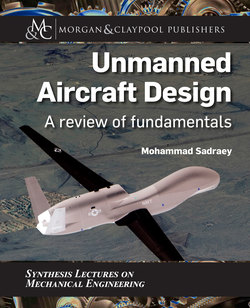Читать книгу Unmanned Aircraft Design - Mohammad Sadraey H. - Страница 8
На сайте Литреса книга снята с продажи.
ОглавлениеPreface
The Unmanned Aerial Vehicle (UAV) is a remotely piloted or self-piloted aircraft that can carry cameras, sensors, communications equipment or other payloads. All flight operations (including take-off and landing) are performed without on-board human pilot. In some reports of DOD, Unmanned Aircraft System (UAS) is preferred. In media reports, Drone is preferred. Mission is to perform critical missions without risk to personnel and more cost effectively than comparable manned system.
The contributions of unmanned aircraft in sorties, hours, and expanded roles continue to increase. As of September 2004, some 20 types of coalition UAVs, large and small, have flown over 100,000 total flight hours in support of Operation Enduring Freedom and Operation Iraqi Freedom. Their once reconnaissance only role is now shared with strike, force protection, and signals collection. These diverse systems range in cost from a few hundred dollars (Amazon sells varieties) to tens of millions of dollars. Range in capability from Micro Air Vehicles (MAV) weighing much less than a pound to aircraft weighing over 40,000 pounds.
The UAV system includes four elements: (1) air vehicle; (2) ground control station; (3) payload; and (4) maintenance/support system. The design of manned aircraft and the design of UAVs have some similarities; and some differences. They include the: (1) design process; (2) constraints (e.g., g-load, pressurization; and (3) UAV main components (autopilot, ground station, communication system, sensors, and payload). A UAV designer must be aware of: (a) latest UAV developments; (b) current technologies; (c) known lessons learned from past failures; and (d) designer should appreciate the breadth of UAV design options.
A design process requires both integration and iteration. A design process includes: (1) Synthesis: the creative process of putting known things together into new and more useful combinations; (2) Analysis: the process of predicting the performance or behavior of a design candidate; and (3) Evaluation: the process of performance calculation and comparing the predicted performance of each feasible design candidate to determine the deficiencies. A designer needs to know how to integrate complex, multi-disciplinary systems, and to understand the environment, the requirements and the design challenges.
The objectives of this book are to review the design fundamentals of Unmanned Aerial Vehicles. It will have three Parts and ten Chapters. Part I (Chapters 1 and 2) is on “Vehicle Design” and covers design fundamentals, and design disciplines. This part covers UAV classifications, design project planning, decision making, feasibility analysis, systems engineering approach, design groups, design phases, design reviews, evaluation, feedback, aerodynamic design, structural design, propulsion system design, landing gear design, mechanical systems design, and control surfaces design.
Part II (Chapters 3–7) is dedicated to the Autopilot Design. It will cover dynamic modeling, control system design, navigation system design, guidance system design, and microcontroller. This part will discuss the topics such as: aircraft aerodynamic forces and moments, stability and control derivatives, transfer function model, state-space model, aircraft dynamics, linearization, fundamentals of control systems, control laws, conventional design techniques, optimal control, robust control, digital control, stability augmentation, coordinate systems, inertial navigation, way-point navigation, sensors, avionics, gyroscopes, GPS, navigation laws, guidance laws, proportional navigation guidance, line-of-sight guidance, lead angle, tracking a command, flight path stabilization, turn coordination, command systems, modules/components, flight software, integration, and full autonomy. A few advanced topics such as detect (i.e., sense)-and-avoid, automated recovery, fault monitoring, intelligent flight planning, and manned-unmanned teaming will also be reviewed in this part.
In Part III (Chapters 8, 9, and 10), equipment design is presented which includes ground control station communication systems, payloads, and launch and recovery. The following topics will be discussed: ground element types, portable ground station, mission control elements, remote control personnel, support equipment, transportation, coordination, hardware and software, radio frequencies, elements of communication system, communication techniques, transmitters, receivers, telemetry, measurement devices, antennas, radar, civil payloads, military payloads, disposable payloads, imagery equipment, payload handling, payload management, payload-structure integration, conventional launch, rail launchers, hand launch, air launch, and recovery systems. Due to the limited length of this book, many topics are reviewed in brief.
Putting a book together requires the talents of many people, and talented individuals abound at Morgan & Claypool Publishers. My sincere gratitude goes to Paul Petralia, Executive Editor of Engineering, and Deb Gabriel for composition. My special thanks go to the outstanding copy editor and proof-reader who are essential in creating an error-free text. I especially owe a large debt of gratitude to my students and the reviewers of this text. Their questions, suggestions, and criticisms have helped me to write more clearly and accurately and have markedly influenced the evolution of this book.
Mohammad Sadraey
July 2017
[Unattributed figures are held in the public domain and are from either the U.S. Government Departments or Wikipedia.]
